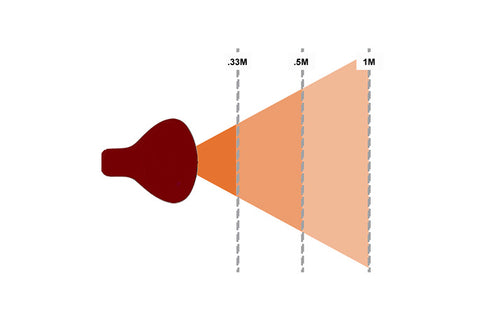TheraBulb Named Top Near Infrared Incandescent 250W Bulb
TheraBulb 250W incandescent infrared bulbs received top ranking in GembaRed LLC’s best of list. GembaRed compared nine major brands of heat lamp bulbs, evaluating them for light uniformity, intensity, and wavelength spectrum. Overall, the TheraBulb near infrared light bulb was ranked second only to GE's and earned the top ranking for intensity.
Light Uniformity
GembaRed evaluated all of the red infrared light bulbs for light uniformity, directing the lit bulbs at a white wall and taking note of the circle of light the bulb cast on the wall. The size of this circle is known as beam spread and, as we explain in our How Many Bulbs Do I Need? blog post, it is one of the factors to consider when determining the number of NIR bulbs to include in an array or infrared sauna. Evaluators found a number of bulbs with shadows and/or hot spots within their beams: “light uniformity was not consistent for many of the bulbs. The bulbs have a ‘shadow’ in the center of the target area, and a ring of a hot spot surrounding the shadow.” Here, TheraBulb's 250W heat lamp bulb scored well, with GembaRed’s evaluators noting, “The lamps with the best concentration of light in the center predictably have higher intensity measurements.”
Intensity, Also Known as Irradiance
Irradiance is the technical term for intensity of light. Irradiance can apply to both visible light, which can be seen with the naked eye, and near infrared energy, which is not perceptible to the naked eye. Whether the light/energy is visible or not, its irradiance decreases as distance from the source increases. (Think of how a lightbulb seems much brighter when you are beside it than when you are across the room from it.) For this reason, irradiance data always includes the distance from the source, such as .33M, .5M, 1M. Irradiance is measured in milliwatts per centimeter squared (mW/cm2), with larger irradiance numbers indicating more energy available at that distance.

Knowing the irradiance of a red light bulb / near infrared bulb lets a user know how much energy the bulb emits at a given distance. This information can be used to compare two or more brands of bulbs or bulbs with different wattages. It can also be used to determine how close to get to the bulb. While safety dictates that 12 inches / .33M is the minimum distance to maintain from the bulb, irradiance data can help users determine the effects of using the bulb at a greater distance. To learn more about irradiance in relation to red light bulbs and near infrared light bulbs, read our blog post Irradiance and Red Light / Near Infrared Bulbs.
Prior to presenting the results of the intensity testing, GembaRed discusses methodology, explaining the importance of using a specialized piece of equipment, the VLP-2000-3W power meter, in a controlled environment. The author observes “Many self-proclaimed ‘experts’ and brands have erroneously used cheap solar power meters. Which solar power meters rely on photodiodes that have limited narrow wavelength ranges of measurements and are calibrated to estimate sunlight intensity, measuring only Red and NIR gives falsely high readings.” Avoiding “irradiance inflation” is the driving factor behind TheraBulb’s decision to use an independent ISO 17025-accredited laboratory rather than a solar meter and tape measure to test our incandescent and near infrared LED bulbs. This allows us to provide customers accurate data on the spectral output, peak wavelength, and irradiance (intensity) of our bulbs.

The evaluators tested each of the nine brands of 250 watt heat lamp bulbs at a distance of 18 inches / .5M and awarded TheraBulb, which registered 264 milliWatts on their scale, the top ranking. In explaining their observations, they referred back to light uniformity, noting “the measurement at the center point shows how the light uniformity plays a big role. Having a big shadow in the middle led to many bulbs having seemingly low intensity with this method of measurement.”
Spectrum
The final feature GembaRed examined was the spectrum of wavelengths each heat light bulb emitted. Unlike the other tests, this one found no significant differences between brands. Each bulb tested emitted nearly the same percentage of each wavelength between 350nm–1100nm. Because visible light (including red light) and infrared energy are defined by their wavelength, this test both verified that the bulbs produce red light (650nm–699nm) and near infrared (700nm–1400nm) and measured the amount of these emissions as a percentage of the total output of the bulb. To learn more about wavelengths and light, review our blog post What is Light?

The only spectral difference noted among the brands was that several “deliver the optical illusion of a deeper red by blocking more orange light in the beginning. This is an aesthetically pleasing result, but would not theoretically alter the benefits much.” Because perceived shade of light, like bulb color, is unrelated to red light and near infrared production, this difference does not affect the performance of the heat lamps (bulbs). To learn more about why there is no connection between heat bulb color and light/energy production, review our blog post Why Bulb Color and Performance are Unrelated.

Learn More
To read the entire article from GembaRed click here: https://bit.ly/3FP468CTo learn more about TheraBulb, review our FAQ page or contact us.


